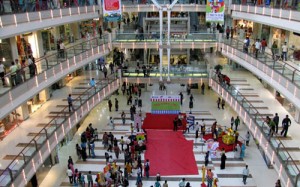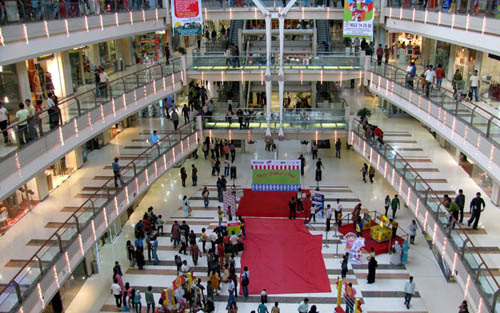 The retail real estate market received a fresh mall supply of approximately 1.94 million sq. ft. (msf) in Q1 2012 (quarter ending March 2012). Many of the expected mall projects were differed on account of delay in construction, leading to a deficit of close to 50% from the estimated supply (3.37 msf) for the quarter, says Cushman & Wakefield in its latest report. This undelivered mall space is expected to get added to the supply for the next quarter which is estimated to be 4.25 msf.
The retail real estate market received a fresh mall supply of approximately 1.94 million sq. ft. (msf) in Q1 2012 (quarter ending March 2012). Many of the expected mall projects were differed on account of delay in construction, leading to a deficit of close to 50% from the estimated supply (3.37 msf) for the quarter, says Cushman & Wakefield in its latest report. This undelivered mall space is expected to get added to the supply for the next quarter which is estimated to be 4.25 msf.
Of the 8 major cities across India, Bangalore led the supply scenario with a total infusion of 1.2 msf. Rental values across most mall destinations across within these cities remained largely stable, except for Ahmedabad, Bangalore and Hyderabad where mall rentals have seen a growth over the previous quarter in the range of 15-30%. Vastrapur in Ahmedabad recorded the highest growth in Mall rents at 33% over last quarter mostly owing to renewals of existing tenants at a higher value.
In the same period, most high streets across major cities recorded significant increase in rental values, as against malls, reflecting the bent of interest amongst retailers for high street properties. Select locations across Hyderabad (A.S. Rao Nagar & Punjagutta) and Bangalore (Vitthal Mallya Road) recorded rental increments upwards of 20% over the previous quarter. A.S. Rao Nagar in Hyderabad saw the highest increase in Highstreet rentals at 26.7% followed by Vitthal Mallya Road in Bangalore at 23%. Kolkata, Chennai and NCR also saw increase in Highstreet rents by 9-14%.
Jaideep Wahi, Director, Retail Services, Cushman & Wakefield commented, “The first quarter of the year has been positive for the retail market and indeed over the last one year. While, the mall space has been moving cautiously to ensure that demand to supply ratio remains stable to maintain rental values, the High Streets continue to see increased demand and interest from a range of retailers.”
Jaideep added further, “Globally, India is being viewed as on an interesting cusp from where retailing can take a quantum leap. The approval for 100% FDI in single brand outlet in India is a crucial step towards restructuring the retail scenario in India. We expect more international retailers to show interest in India which would eventually lead to a more structured approach towards Retail Real Estate in India.”
NCR’s retail market was largely driven by leasing activities on the High Streets where retailers showed greater interest. South Extension I & II (9.10%), Karol Bagh (7.7%) and Connaught Place (4%) registered a rise in rental values on account of enquiries from retailers and some significant leasing activities. Malls on the other hand continued to see cautious approach by retailers thereby witnessing limited supply and restrictive leasing activities. Part of the problem in retail malls scenario in the city is the limited availability of quality space which has been dithering retailers to commit to the existing space because of which vacancy levels remained unchanged at 28% from the previous quarter. Rentals across the mall space remained unchanged from the previous quarter and incidentally from the last year as well.
Mumbai’s retail market remained stable with both High Streets and Malls space rentals unchanged over the previous quarter. No new addition to mall space and limited leasing activities on High Street was largely due to unavailability of quality retail space within the city. The only micro market to record an increase in rental values was Vashi (7%) for malls, where a churn in the existing malls led to an upward recalibration of rental values. Going forward the latent retail interest for the city is expected to remain high and retailers will be keen on having both High Street as well as mall presence.
In Bangalore, Vitthal Mallya Road was the hot bed for retail action with both High Street as well as Mall space in the location recording a growth in rental values – High Street rentals increased by 25% q-o-q and mall rentals grew by 14% q-o-q. The location has been witnessing some rapid increase in retail activities owing to the presence of the city’s only Luxury Mall that has been garnering interest from premium brand retailers. Other than that the advantage of being surrounded by a good retail catchment area has been the key to the location’s rise. A new mall of 1.3 msf became operational with nearly 80% occupancy notwithstanding that quality mall space is still relatively scarce because of which mall vacancies remained at a manageable 10%.
In Hyderabad, persistent leasing enquiries and scarcity of suitable space pushed rentals upwards in the range of 9% to 20% across the city’s prime High streets and mall locations. Retailer demand for space in Hyderabad has been high on account of the favorable consumer demand and also affordable rentals (as compared to other cities in India). With this several high-end/small format retailers actively evaluating space options, developers are willing to customize their spaces in order to accommodate expansion plans for the under-tapped retail potential in the city. The high demand for retail has led to vacancy of less than 2% in existing malls where retailers are conceding to renew their contracts with developers on higher rentals to avoid relocation.
Rental values across Malls and High Streets remained unchanged from previous quarter largely due to unavailability of leasable space reflected in a status quo. The only exception was Khader Nawaz Khan Road saw robust demand resulting in noticeable rental appreciation. The city witnessed increased vacancy levels of 8.2% due to new mall getting relatively lower occupancy. However, the mall vacancy in suburban markets registered a marginal dip due to moderate leasing activity. It is expected that the rentals on most High streets are likely to remain stable, however, some markets like Khader Nawaz Khan Road and Velachery are likely to see rental escalations in the forthcoming months as a result of anticipated demand and already limited space.
In Pune, while retailers showed optimism as a new mall became function with 80% occupancy in the first quarter of 2012, rentals remained stable due to sizeable vacancy in the mall at around 20%. It is expected that there will be marginal drop in mall rentals, due the influx of approximately 700,000 sf of additional mall space in the in the micro market of Hadapsar. Lack of available space in the High street led to stable rentals across the city. The High streets are likely to witness some escalation in rentals due to the lack of quality space and continued enquiries from international brands looking to establish their presence in these micro markets.
In Ahmedabad, there was buoyant demand for mall space, with retailers relooking at the city with renewed interest. Previously Ahmedabad suffered from lack of quality mall space but in the last quarter Vastrapur has seen some leasing activities on account of quality development and appropriate mix of tenants. The corresponding increase in rental values in Vastrapur was recorded at 33%. Vacancy in city Malls however remained high at 36% as some of the older malls space continued to remain vacant. In High Street, stable demand and limited quality availability resulted in price appreciation on S.G. Road and Satellite Road. In Ahmedabad, demand for retail space is diversified to categories such as Telecom and BFSI that also look at retail hotspots for their customer related operations.
Kolkata’s traditional High Street locations of Park Street, Camac Street and Elgin Street all recorded notable increase in rental values on account of continued interest from retailers. The mall spaces on the other hand did not see changes in rental values even though there were enquiries and some leasing as well. This is largely because there is limited space available for any major transaction within the malls leading to a status quo. Having said that, the threshold of price increase that the malls can afford to inflict is also low because of which, mall developers would be judicious in escalating prices even while demand is reasonably favourable.





